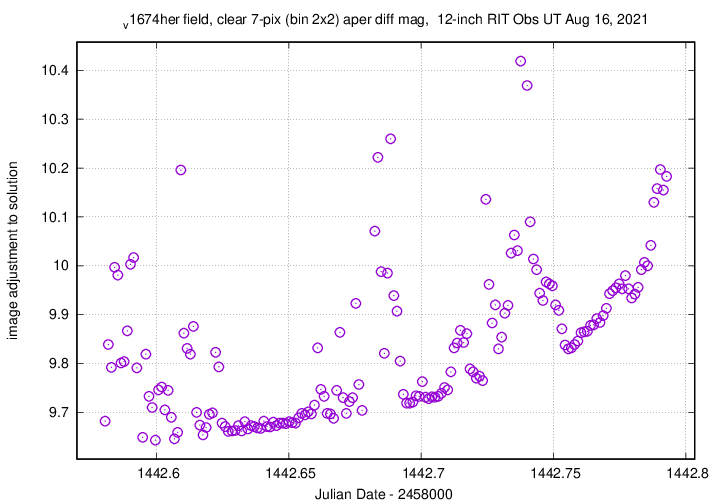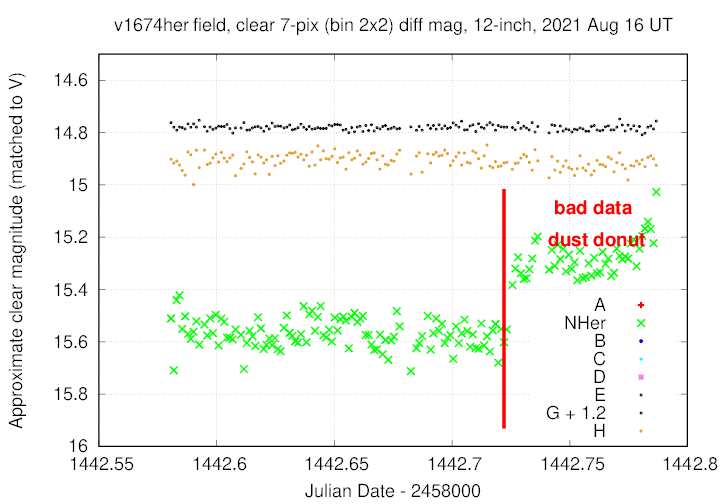
On the night of Aug 15/16, 2021, under fair conditions, I acquired images of Nova Her 2021 = V1674 Her. One can find information about it at
This object has continued to fade slowly since my last measurements of it. I tried using 90-second unfiltered images tonight, and they don't provide enough signal-to-noise to see the small (0.1-ish mag) variations. The target also drifted into a dust donut, forcing me to discard several hours of measurements. I think I'll give up on this object.
This object was discovered by Seiji Ueda (Kushiro, Hokkaido, Japan) on 2021 June 12.537 UT. It rose quickly, then fell quickly.
An update from Enrique de Miguel, from vsnet-chat:
You guys are doing a nice coverage of the recent nova V1674 Her. At this stage, with the nova event so recent and with so many non-trivial effects still going on, detecting periodicities is not straightforward. The alledged spin signal (~8.4 min) seems to be there, but the amplitude is very low in the optical range. If this is a true periodicity (which most likely is) it will presumably become more apparent as the ongoing fireworks fade away. A second signal is now becoming increasingly important at ~0.152 d (~3.66 h) which, if shown to be stable, points to the orbital signature of the binary. So if we want to define the orbital wave properly, runs as long as possible are really a must.
The main setup was:
Notes from the night:
The object is located at
RA = 18:57:30.95 Dec = +16:53:39.6 (J2000)
A chart of the field is shown below. The size of the chart is about 31 x 26 arcminutes.

I've marked the location of several comparison stars as well. See
I'll use star "E" to shift my instrumental magnitudes to the V-band scale. It has a V-band magnitude (according to AAVSO chart X26675JQ) of 12.221, and (B-V) = 0.608.
The faint star marked "var" shows variations of size roughly +/- 0.3 mag in a roughly sinusoidal pattern over the run. It's perhaps an eclipsing binary. The star has magnitude V ~ 13.5 and position
RA = 18:57:04.13 Dec = +16:46:00.9 (J2000)
= 284.26722 = +16.76692
This star has measurements in the ASASSN Variable Star database:
I took a photo of the finder TV's screen when pointing to this target; this could be a useful reference for the future:
The sky value shows clouds coming late, then leaving a short time before dawn.

The FWHM graph below shows a pretty steady value, decreasing a bit after I refocused around midnight.

Using aperture photometry with a radius of 7 pixels in a V filter (binned 2x2, each pixel is 1.24 arcsec, so a radius of 8.7 arcsec), I measured the instrumental magnitudes of a number of reference stars and the target. Following the procedures outlined by Kent Honeycutt's article on inhomogeneous ensemble photometry, I used all stars available in each image to define a reference frame, and measured each star against this frame.
Sigma-vs-mag plots show that the floor was about 0.007 mag.

Note the brief periods of cloud marked by increases in the ensemble zero-point.

Here is the light curve of the object and several field stars in the V filter; I've shifted the instrumental magnitudes so that star "E" = 000-BMD-913 on AAVSO chart X26675JQ has the value given by AAVSO as its V-band magnitude. The faint variable star is labelled as "X".

Note the low signal-to-noise of the target, due to its faintness.

I have submitted these measurements to the AAVSO, CBA, and VSNet.
You can download my measurements below. A copy of the header of the file is shown to explain the format.
# Measurements of Nova_Her_2021 made at RIT Obs, UT 2021 Aug 16, # in fair conditions, # by Michael Richmond, # using Meade 12-inch LX200 and ATIK 11000. # Exposures 90 seconds long, clear filter. # Tabulated times are midexposure (FITS header time - half exposure length) # and accurate only to +/- 1 second (??). # 'mag' is a differential magnitude based on ensemble photometry # using a circular aperture of radius 7 pix = 8.8 arcseconds. # which has been shifted so AAVSO 000-BMD-913 has mag=12.221 # which is its V-band magnitude according to AAVSO. # # UT_day JD HJD mag uncert Aug16.08059 2459442.58059 2459442.58428 15.511 0.052 Aug16.08179 2459442.58179 2459442.58548 15.709 0.055
Last modified 8/16/2021 by MWR.